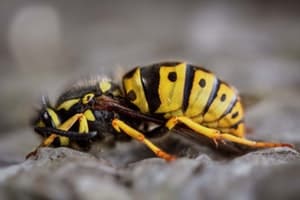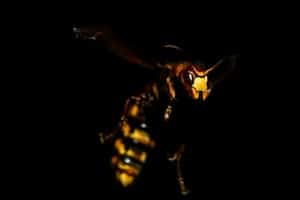In most areas, cool night temperatures prevent the wasps from flying at night. A wasp will not fly properly at night if the temperature is below 50 degrees Fahrenheit. The worker wasps will mostly fly towards the lighted windows at night and therefore collide with the glass windows. Wasps that remain inside their nest at night do not sleep. They spend their time feeding the offspring and tending the nest.
So, do wasps and hornets come out at night? Even though most wasps do not fly at night, Hornets (a type of wasps) do. The European hornet, which is the only species of hornets you will find in the United States, Apoica wasps, Ichneumonid wasps and Braconid wasps fly at night if the weather is calm.
Table of Contents
Main difference between wasps and hornets?

The primary difference between hornets and wasps is that wasps live in smaller colonies with less than 100 wasps, while the Hornets live in very large colonies. It can be hard to differentiate between the thin-bodied, hairless and bee-like insect. Apart from the size of colonies, the shape of nest and placement forms the other important difference. Wasps will build their homes in the open and the nests are umbrella-shaped and suspend from solid objects on protected locations like the eaves supporting your covered porch roof. On the other hand, hornets build larger enclosed nests in shrubs or tree branches. Both wasps and hornets will guard their homes fiercely if threatened. Therefore, you have to avoid them.

You can also examine the size, colours and markings to know whether you are dealing with wasps or hornets. The nesting behaviours, temperaments and living situations will also help you differentiate them. Wasps are slightly larger than hornets and their bodies are narrower. They also have a narrower waist, which the Hornets do not have. Unfortunately, wasps exist in various colour combinations and variations. Moreover, they have two primary nesting habits – social and solitary. The solitary wasps include spider wasps, ichneumon wasps and mud daubers and they burrow for the females to lay their eggs. Their nests are small and hard to see. Hornets are black with yellow stripes, black with white stripes or black with brown stripes.
When are wasps and hornets most active?
Wasps and hornets are an important part of the environment and function at the highest level in the hot summer months. They are arachnids and eat most of the pest insects including caterpillars and ants, by laying eggs on or in spiders and other insects so that the newly hatched wasp larvae can eat them. Just as you expect with bees, wasps help in pollination.
Hornets are active throughout the day and most of the night, while most wasps are active during the day. The Hornets that remain active during the night are the infertile females, who find food for the larvae and build the nests. Workers do their job during the day and night but rest during the morning hours – just before sunrise. They stir as the sun rises. They are more active in summer and will die as the cold weather appears. Here is what happens during the cold and hot months.
The queens in April
In April, young queens will awaken from the winter slumber and start building their nests, which they make from chewed up wood fibre cemented with saliva. The role of queens is to populate nests with newly hatched workers. They fertilize the eggs with the sperms they collect in the previous autumn. The eggs hatch into new infertile female workers who adopt the job of enlarging the nest and making new cells so that the queen can lay more eggs in them.
The nests in May
In May, the queens continue laying their eggs in individual cells so that they can hatch into larvae. The worker wasps continue feeding them. In the first part of May, the second group of newly hatched larvae will pupate into workers. The process happens repeatedly throughout the summer month. At the end of May, other groups of workers will have joined the first group and will help in the building of the nest and care for the larvae.
Worker wasps between June and July
In both June and July, wasps will reach their full activity level and their nests grow rapidly in size. By July, thousands of wasps will have pupated to adulthood and others will be resting in eggs or recently hatched. The thousands of new adult wasps get out of the nest on a daily basis to get food in the form of insects such as caterpillars to feed the larvae in nests.
August, September and October
In August, September and October, wasps wind down their activities. The workers will die and the queens will slow down their egg laying. In the three months, she lays eggs that hatch into fertile females and males instead of the infertile female workers. The queen will die during this time so that the young queens can mate with the males and fly away. The fertile males die last.
Are there nocturnal wasps and hornets?
If someone mentioned the word wasp, the first thing that would get into your mind is a black and yellow striped insect with a very painful sting. Even though most wasps will fit this description, most of them come with varying shapes, sizes, behaviours and colours. Some of the wasps are nocturnal, which means that they will fly only during the night. Some of these nocturnal wasps are parasitic and they will lay their eggs near or on the night-feeding caterpillars and some other hosts. Others will search for the nocturnal insects like crickets and moths to offer to the larvae as food. Wasps that fly during the night include the European Hornets and those from Ichneumonidae, Apoica genus and the Brachonidae families.
Insects, including wasps and hornets, have compound eyes consisting of many individual parts known as ommatidia. Most of them also have three smaller individual visual organs known as ocelli at the top of their head. Any nocturnal insect has adaptation on its compound eyes and the ocelli so that it can see clearly and fly in the dark. The European hornets are an exception.
The European Hornets
The European Hornets are large social wasps that exist in large distributed groups known as Vespidae. The Hornets make papery nests for the young ones. Unlike most other vespid wasps such as hornets that remain active during the day and yellowjackets, European hornets are capable of flying in the dark. They search for grasshoppers and the other insects or take parts of the ripening fruits to feed the young ones. The large wasps have a length around 1 inch and their upper body and the head is reddish-brown. Due to the large size, and large eyes, the Hornets do not require special visual adaptations, which other nocturnal insects possess.
Apoica Wasps
European hornets are in the same class as the European hornets and have real nocturnal behaviour. The Apoica wasps always gather around the entrance of their nest to protect the larvae during the day. They rely on ocelli adaptations to get food during the night.
Ichneumonid wasps
The Ichneumonid wasps have slender bodies and long egg-laying organs known as ovipositors. The wasps look threatening but most of them do not sting. They are parasitic and their size, pattern and colour vary depending on species. The adults lay their eggs on host insects, mostly spiders or caterpillars and the larvae will feed off the host. Most species in this group are nocturnal.
Braconid wasps
Generally, the Braconid wasps are brown or black. They are parasites of most other insects such as butterflies and moths. Light will attract them at night when searching for the hosts. They have large eyes, which along with the ocelli help them fly at night.
Are there crepuscular wasps and hornets?
Some wasps and hornets are crepuscular (dawn or dusk) feeders. Hornets are large social wasps and are known for their nocturnal nature. Some of them have anatomical and optical adaptations that help them fly in dim light. They have larger compound eyes and ocelli in addition to large facet lenses and hornet eyes. Their eyes are also less sensitive than those of diurnal wasps are. Therefore, some species are able to see in dim lights because of their eye size and large body.
Do all species of wasps and hornets behave the same at night?
Typically, wasps and hornets are not the same. Some fly during the day and others at night. Those that fly at night are always out in the dark searching for hosts and food. Others search for food during the day and become less active during the night. In winter, both wasps and hornets will hibernate. Their body systems slow down due to cold temperature and that is why most of them are active during the warm weather and during the day.
Therefore, if you want to remove wasp nests from your home, you should consider doing that during the nighttime hours and dusk. At night, most of the wasps will have occupied their nests to take other duties such as feeding the young ones, so removal of a colony is easier. When they are less active, the wasps are less likely to attack.
Conclusion
Because hornets and wasps are likely to remain in the nest during the morning hours, you should destroy them during the hours. Avoid using a flashlight or any other source of light to locate their nest openings because the artificial light might invite attacks. You will have to spray or apply appropriate pesticides on the nest openings. The best thing to do is to engage a professional.

Twice when a hornet got in the house at night, a wasp did too. Both times one was large, straight, and dark brown (hornet) while the other was as long but not as wide, segmented, and yellow with black stripes (wasp). Just wondering if there is any reason why both would come in at the same time.
Try looking at this post, What Are Wasps Attracted To?, it may give you some answers. It may just be coincidence but it could be that the weather conditions drove them inside if you had a more attractive ambient temperature and humidity indoors.
I have a nest, the size of a saucer, in the eves of my shop. Lately, the wasps have clustered on the nest and in small groups of 15-30 down the rafter. One of the ‘clusters’, dropped down all together, almost on my head. The whole group just fell at me. (No other way to describe it). Do wasps hang around the nest when they first hatch. I did not disturb them, they came at me. (About 10ft above me). Is this normal? The nest was almost black in color so I knew they were hatching.
THANK YOU
Donna
I have photos bit couldn’t attach them.
Thank you for your comments. I would recommend that you contact your local pest control to deal with this nest, especially since it is in your shop. Depending on the type of wasp you may find them more or less aggressive.
Please help…..I live in Florida and have never had a problem with wasps/hornets, but within the last 2 weeks like clock work our security light comes on at dusk and dawn and out they come. They are smaller in size ( maybe juvenile) not aggressive, but very annoying. I can’t sit on my front porch anymore plus my cats won’t even sit on the front porch anymore. They have landed on me before and I just shake them off, so far they have not tried to sting me. I’ve looked for a nest but can not find one. Any suggestions on how to get rid of them? The are small, black and yellow. I’m at a loss. Please help.